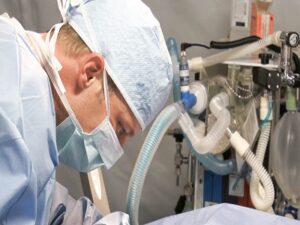 Here is a list of commonly used instruments and equipment in anesthesia:
Here is a list of commonly used instruments and equipment in anesthesia:
- Anesthesia Machine: The primary device used to deliver a precise mixture of gases (oxygen and anesthetic agents) to the patient.
- Endotracheal Tube: A tube inserted into the patient’s trachea to maintain a patent airway and facilitate mechanical ventilation.
- Laryngoscope: A device used to visualize the vocal cords and guide the placement of an endotracheal tube.
- Bag-Valve-Mask (BVM) Device: Also known as an Ambu bag, this is used to manually ventilate the patient by squeezing a bag to deliver air/oxygen.
- Ventilator: A machine that assists or controls a patient’s breathing by delivering a specific amount of air and oxygen.
- Pulse Oximeter: Monitors the patient’s oxygen saturation (SpO2) by measuring the percentage of hemoglobin saturated with oxygen.
- Capnograph: Measures the concentration of carbon dioxide (CO2) in the patient’s exhaled breath, helping to assess ventilation.
- Blood Pressure Monitor: Measures the patient’s blood pressure, which is crucial for monitoring cardiovascular status.
- ECG Monitor: Displays the patient’s electrocardiogram, helping to monitor heart rate and rhythm.
- Temperature Monitoring: Various devices are used to monitor the patient’s body temperature during surgery.
- Invasive Blood Pressure Monitoring Kit: Used to directly measure the patient’s blood pressure by inserting a catheter into an artery.
- Central Venous Catheter: A catheter inserted into a large vein, often in the neck or groin, to monitor central venous pressure and administer medications.
- Peripheral Intravenous (IV) Catheters: Used to administer fluids, medications, and anesthesia agents.
- Neuromuscular Blockade Monitoring: Devices that measure the depth of neuromuscular blockade, helping to assess the patient’s response to muscle relaxants.
- Anesthesia Gas Monitors: Measure the concentration of anesthetic gases in the patient’s breath.
- Nerve Stimulator: Used to locate nerves and guide the placement of regional anesthesia, like nerve blocks.
- Syringes and Needles: Used to administer medications, including anesthetic agents and other drugs.
- Anesthesia Workstation: Software used to track patient data, calculate drug dosages, and manage anesthesia care.
- IV Pumps: Infuse fluids and medications at controlled rates via intravenous lines.
- Fluid Warmer: Warms intravenous fluids to prevent hypothermia during surgery.
- Suction Devices: Remove fluids and secretions from the patient’s airway during surgery.
- Pain Assessment Tools: Various tools and scales used to assess the patient’s level of pain and response to analgesics.Please note that the specific instruments used can vary based on the type of surgery, patient’s condition, and the preferences of the anesthesia team.


